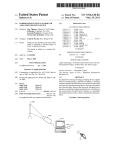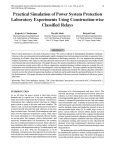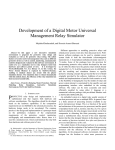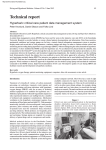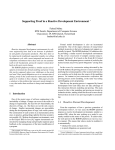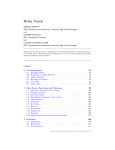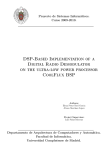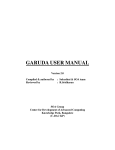Download main
Transcript
Published for SISSA by Springer Received: March 6, Revised: May 2, Accepted: May 30, Published: June 17, 2014 2014 2014 2014 Cynthia Keelera and Gim Seng Ngb a Michigan Center for Theoretical Physics, Randall Laboratory of Physics, The University of Michigan, Ann Arbor, MI 48109-1040, U.S.A. b Center for the Fundamental Laws of Nature, Harvard University, 17 Oxford Street, Cambridge, MA 02138, U.S.A. E-mail: [email protected], [email protected] Abstract: In this note, we calculate the one-loop determinant for a massive scalar (with conformal dimension ∆) in even-dimensional AdSd+1 space, using the quasinormal mode method developed in [1] by Denef, Hartnoll, and Sachdev. Working first in two dimensions on the related Euclidean hyperbolic plane H2 , we find a series of zero modes for negative real values of ∆ whose presence indicates a series of poles in the one-loop partition function Z(∆) in the ∆ complex plane; these poles contribute temperature-independent terms to the thermal AdS partition function computed in [1]. Our results match those in a series of papers by Camporesi and Higuchi, as well as Gopakumar et al. [2] and Banerjee et al. [3]. We additionally examine the meaning of these zero modes, finding that they Wick-rotate to quasinormal modes of the AdS2 black hole. They are also interpretable as matrix elements of the discrete series representations of SO(2, 1) in the space of smooth functions on S 1 . We generalize our results to general even dimensional AdS2n , again finding a series of zero modes which are related to discrete series representations of SO(2n, 1), the motion group of H2n . Keywords: Gauge-gravity correspondence, AdS-CFT Correspondence, 1/N Expansion ArXiv ePrint: 1401.7016 Open Access, c The Authors. Article funded by SCOAP3 . doi:10.1007/JHEP06(2014)099 JHEP06(2014)099 Partition functions in even dimensional AdS via quasinormal mode methods Contents 1 2 Applying the zero-mode method to AdS2 2.1 Finding the zero modes 2.2 Summing the contributions of the zero modes 2.3 Finding Pol(∆) via local curvature invariants 2.4 Comparison with full eigenfunction heat kernel method 3 5 5 6 8 3 Two interesting properties of AdS2 zero modes 3.1 Zero modes Wick rotate to quasinormal modes 3.2 Zero modes as discrete series representations 10 10 12 4 The thermal partition function on AdS2 4.1 T -dependent portion of Z(∆) in thermal AdS2 4.2 Partition function on thermal AdS via heat kernel on quotient of hyperbolic space 13 13 5 Extension of story to all even dimensions 5.1 Finding Pol(∆) for d + 1 = 4 5.2 Comparison between thermal partition function in quasinormal mode and heat-kernel method 14 16 6 Discussions and conclusions 18 A Finding zero modes in AdSd+1 for d + 1 even 19 B Euclidean disc vs. global coordinates 21 1 14 17 Introduction Quantum effects in AdS spacetimes are of great interest to the theoretical physics community, particularly since the advent of the AdS/CFT correspondence nearly two decades ago. Even leading one-loop effects can contain important physical results. For example, quantum corrections to the entropy of black holes can be computed using the quantum entropy function [3–5], which requires the one-loop effective action due to the matter fields on an AdS2 × M spacetime. As such, there is interest in developing efficient methods for various one-loop calculations. Several methods for calculating the one-loop determinant for a particular field fluctuation are already known, mostly based on the heat kernel method (see e.g. [6]). There are –1– JHEP06(2014)099 1 Introduction several known ways to calculate the heat kernel. First, if one is only interested in large mass behavior (for a massive field of mass m), the curvature expansion in terms of local invariants is known for many field types up to 10th order [6]. If we wish to know the heat kernel outside of a 1/m expansion, then we can expand the heat kernel as a sum over normalized eigenfunctions of the Laplacian weighted by their eigenvalues; this is the approach used in the series of papers [7–10] and again by [3] for AdS2 × S 2 spacetimes. These eigenfunctions are generally special functions and the details, particularly for higher spin fields, can be challenging. In two papers [1, 12], Denef, Hartnoll and Sachdev developed a method1 not directly based on the heat kernel approach. In this method, developed from an argument in [15] (also see [16, 17]), the partition function Z(∆) (of a massive scalar of mass m) is calculated via a complex analysis trick.2 Rather than specifying a physical mass m (corresponding to a particular conformal dimensional ∆), and then calculating the partition function at that mass, this method studies Z(∆) as a function in the complex ∆ plane. If we assume Z(∆) is a meromorphic function in complex ∆ plane,3 then to find the function completely we need only the location and multiplicities of its poles and zeros, as well as one (entire) function which we term exp[Pol(∆)], where Pol(∆) is some polynomial of ∆. In the case of Z(∆), this extra function is completely constrained by the behavior of the function at large mass; that is, we can use the heat kernel curvature expansion to completely determine Z(∆). As shown in [1], for scalars Z(∆) has only poles; these poles are due to zero modes in Euclidean space, which Wick-rotate to quasinormal modes in Lorentzian signature (or normal modes in global Lorentzian AdS). As such we will use the term “zero mode method” when working in Euclidean signature, but “quasinormal mode method” when working in Lorentzian signature. In fact [1] does provide a formula for thermal AdS using a “normal mode” method, referencing the global normal modes. For odd-dimensional AdS spacetimes, these modes are sufficient and, as shown for AdS3 in [1], they correctly reproduce the partition function in [21]. However, as we will show in this paper, on even-dimensional AdS spacetimes the normal modes are insufficient. Although the normal modes capture all temperature-dependent information (which is often the behavior of primary interest), if one wants to obtain the temperature-independent piece, the normal modes are insufficient. Since the temperature1 Although we will primarily discuss the case of AdS2n in this note, this method actually applies to the case of de Sitter space as well, as was discussed in the original paper of [1]. It would be interesting to understand the relations between the interpretation of de Sitter quasinormal modes as highest-weight representations [13, 14] and their roles in this 1-loop partition function method. 2 This method has been generalized to fields of arbitrary spin on AdS3 in [18–20]. 3 This assumption is reasonable; we will apply boundary conditions in terms of ∆, and there is no reason to expect a branch cut or essential singularity in Z(∆). –2– JHEP06(2014)099 Of course these eigenfunctions of the Laplacian themselves arise from the group theory structure of the spacetime; the Laplacian is the quadratic Casimir for the motion group of the space. As such Gopakumar et al. developed a method for computing the heat kernel from group theory characters [11], which they extended to AdSd+1 for d ≥ 2 in [2]. This powerful method works well for spacetimes where we understand the group theory structure. 2 Applying the zero-mode method to AdS2 In this section, we use the zero-mode method to calculate the 1-loop partition function for a complex scalar φ with mass m in Euclidean AdS2 with AdS length L. We begin by setting notation and briefly reviewing the zero-mode method from [1]. We will extend their method for compact spaces to the non-compact AdS2 . We work in coordinates ds2E = L2 dη 2 + sinh2 η dθ2 , θ ∼ θ + 2π, η ≥ 0, (2.1) where η → ∞ is the boundary. Writing the partition function in terms of the scalar determinant we have: Z R ∗ 1 2 2 , (2.2) Z(∆) = Dφ e− φ (−∇ +m )φ ∝ det (−∇2 + m2 ) where ∆ solves (mL)2 = ∆(∆ − 1). Here, we choose the root ∆ according to the standard Dirichlet boundary condition for AdS2 , i.e. we impose the Dirichlet-type boundary condition φ ∼ (sinh η)−∆ for η → ∞, r 1 1 1 ∆≡ + + m2 L2 ≡ + µ, 2 4 2 at the AdS boundary. –3– (2.3) JHEP06(2014)099 independent piece contains logarithmic behavior, its presence is needed to show Pol(∆) is truly polynomial. To properly compute this piece, it is necessary to include a set of modes whose boundary “falloff” is set by ∆. However these modes are nonetheless not normalizable, because they are located in the complex ∆ plane on the negative real axis. In the case of AdS2 , we will see that they are still interpretable as a set of quasinormal modes. In section 2, we apply the zero mode method to compute the scalar one-loop determinant on Euclidean AdS2 , or H2 . In the process we review the details of the method. We then compare our results to previous results, finding agreement. In section 3, we explore the physical and mathematical meaning of the novel zero modes we have found, with the hope of better understanding when such modes might be present in other spacetimes. In section 4, we study the thermal AdS2 as a quotient space of H2 . We show our results from section 2 can be combined with those of [1] to match the thermal partition function as computed via the methods of [2], including the temperature independent piece. In section 5, we extend our analysis to general even-dimensional AdS spaces, again matching with previous results. In the conclusion, we discuss application of this method to odddimensional AdS spaces, and also highlight important caveats to consider when applying the zero/quasinormal mode method. The appendix contains further calculational details. In order to calculate the determinant, we will use the method developed in [1]. If Z is a meromorphic function of ∆, then we can use the Weierstrass factorization theorem4 from complex analysis to find the function. Under this theorem, if we know the poles and zeros (and their multiplicities) of a meromorphic function, then we know the function itself, up to a factor which is an entire function. The determinant we are interested in will have no zeros, only poles, so we can write Z(∆) = ePol(∆) Y i (∆ − ∆i )−di , (2.4) ∆⋆ (∆⋆ − 1) 2 φ⋆ = 0, −∇ + L2 (2.5) where φ⋆ is smooth in the interior of the (Euclidean) AdS, and satisfies the boundary condition (2.3). That is, at these (generally complex) ∆⋆ , φ⋆ is a zero mode. Thus at ∆ = ∆⋆ , Z(∆) has a pole; the degeneracy of this pole is the number of smooth solutions to (2.5) which also satisfy (2.3). For a spacetime with a compact direction, these ∆⋆ can be labelled by a discrete index i; we call this set the ∆i . As we will show for AdS2 , even a noncompact space may have a discrete set of poles, when we choose the appropriate boundary condition. As shown in [1], for spacetimes which are Euclidean black holes, these zero modes Wick rotate to become quasinormal modes of the corresponding Lorentzian black holes. We will discuss the details of this Wick rotation in the Euclidean AdS spacetime in section 3.1 below. As a preview, the zero-mode method for calculating the 1-loop determinant has three steps, which we will explain in detail as we proceed: • Find ∆i where there exists a zero mode φi , and the multiplicities di of these zero modes. • Use eq. (2.4) to express Z(∆) in terms of these ∆i and di . Zeta-function regularize log Z(∆) to perform the infinite sum. • Find the polynomial Pol(∆) by matching the zeta-function regularization at large ∆ to the local heat kernel curvature expansion expression for log Z(∆). 4 The initial version of the Weierstrass factorization theorem only applies to analytic functions, but it can be extended to meromorphic functions. Additionally convergence of infinite products will not concern us, so we do not worry about using the proper Weierstrass factors. If we include information from the growth behavior at large ∆, which we will have from the heat kernel curvature expansion, we could use instead the Hadamard factorization theorem; here we will not need these complications. –4– JHEP06(2014)099 where the ∆i are poles (of Z(∆)) each with degeneracy di . Importantly, Pol(∆) is a polynomial in ∆, since ePol(∆) is entire. We find the poles in Z(∆) by searching for values of ∆ where det −∇2 + m2 becomes zero. These ∆⋆ occur whenever there exists a φ⋆ solving 2.1 Finding the zero modes The first step is to find the zero modes in the complex ∆ plane. Following [10], the solutions to (2.5) which are regular at η = 0 in Euclidean AdS2 can be written as h η i φ∆l = eilθ (i sinh η)|l| F ∆ + |l|, |l| + 1 − ∆; |l| + 1; − sinh2 , (2.6) 2 ∆⋆ ∈ Z≤0 , |l| ≤ −∆⋆ . (2.7) In other words, at each nonpositive integer ∆⋆ , we have a zero mode of multiplicity −2∆⋆ + 1. There are no other zero modes for any ∆ in the complex plane. Since these zero modes occur at integer values ∆⋆ , they are discrete. In order for the zero-mode method to work, we require a discrete set of poles; if the set of poles had an accumulation point (other than infinity), the Weierstrass theorem would not apply. As we will discuss further in section 3 below, these modes have several interesting physical and mathematical properties. They are the Wick-rotation of quasinormal modes for AdS2 black holes, as well as the manifestation of the discrete series representation of the SO(2, 1) symmetry of AdS2 , on the space of smooth functions on the circle S 1 . 2.2 Summing the contributions of the zero modes For now, as we have found a discrete set of zero modes, we continue our calculation of the AdS2 complex scalar partition function by evaluating log of (2.4):6 X (2∆⋆ − 1) log (∆ − ∆⋆ ) , log Z(∆) = Pol(∆) + ∆⋆ ∈Z≤0 = Pol(∆) − ∞ X (2k + 1) log(∆ + k), k=0 ′ = Pol(∆) + 2ζ (−1, ∆) − (2∆ − 1)ζ ′ (0, ∆). 5 (2.8) We use this boundary condition in accordance with AdS/CFT intuition. We will show in section 2.4 below that this choice agrees with the results from the heat kernel eigenfunction expansion done over deltafunction normalizable modes. The agreement is a consistency check that our boundary condition produces the same result. It would also be interesting to understand why these two prescriptions are equivalent. 6 One might recognize these expressions as similar to that of the computations of dS2 in [1]. There are two important differences: first, due to the AdS Dirichlet boundary condition, we are only summing over the ∆ boundary condition here (and not 1 − ∆). Second, the relationship between ∆ and the mass for AdS differs by a sign from that for de Sitter. –5– JHEP06(2014)099 where F is the hypergeometric function also written 2 F1 . We have already imposed part of the boundary condition at the origin by choosing the solution of the hypergeometric equation which is regular at η = 0. To impose that φ∆l be single-valued due to periodicity of θ ∼ θ + 2π, we additionally impose l ∈ Z. Now, rather than imposing delta-function normalizability as in [10], we impose the boundary condition by insisting the modes have only the Dirichlet-like behavior (sinh η)−∆ as η → ∞. That is, we wish to turn the behavior (sinh η)∆−1 off entirely.5 Using the result (A.8) from appendix A, this is accomplished whenever ∆ = ∆⋆ where where we have used zeta function regularization as in [1].7 Here ζ(s, x) is the Hurwitz P −s ′ zeta function defined by analytic continuation of ζ(s, x) = ∞ k=0 (x + k) , and ζ (s, x) ≡ ∂s ζ(s, x), whose large ∆ behavior is given in [1] (which is taken from appendix A of [22]) as: ∞ ζ(s, ∆) ≃ 1 X (−1)k Bk Γ(k + s − 1) , Γ(s) k! ∆k+s−1 (2.9) k=0 where we have replaced Pol(∆) with Pol(µ), as a polynomial in ∆ is also a polynomial in µ. 2.3 Finding Pol(∆) via local curvature invariants Now we still must compute Pol(∆), which we do by studying the behavior of Z(∆) at large ∆, via a heat kernel curvature expansion. Specifically, we set Pol(∆) by requiring log Z(∆) = const. + (4π)− d+1 2 d+1 X k=0 ak Z ∞ 0 dt k−d−1 −tm2 t 2 e + O(m−1 ), t (2.11) where ak are the kernel curvature coefficients, in our case for the operator −∇2 . When there is no boundary contribution, the curvature invariants ak = 0 for odd k while for even R √ k, ak ≡ dd+1 x gak (x) can be expressed following [1] as a0 (x) = 1, a2 (x) = R , 6 a4 (x) = 1 (12∇2 R + 5R2 − 2Rµν Rµν + 2Rµνρσ Rµνρσ ), (2.12) 360 where we have included a4 for use in future sections. Setting (2.11) equal to the large µ expansion (2.10), we solve for Pol(∆), which must be a polynomial. If it is not possible to set these two expressions equal by fixing Pol(∆) to be a polynomial, than either some zero modes have not been included in the sum, or the meromorphicity of Z(∆) is suspect. On the other hand, if we can equate these expressions with a polynomial Pol(∆), then that provides a nontrivial check on our calculation. 7 More complicated spacetimes might require use of a generalized zeta function, such as the multiple Barnes zeta function, but we will find the Hurwitz function sufficient here. –6– JHEP06(2014)099 where Bk ’s are the Bernoulli numbers. Since we will find Pol(∆) by expanding the expression (2.8) at large ∆ and comparing to Z(∆) as found from the heat kernel curvature expansion, we now present the expansion of the zeta-function expression. In order to compare more easily with the heat kernel expansion, we also expand in terms of µ = ∆ − 1/2 as in (2.3). Expanding eq. (2.8) at large ∆ in terms of µ, using (2.9), gives 3 2 1 1 1 2 log Z(∆) = Pol(∆) + ∆ − ∆ − ∆ −∆+ log(∆2 ) + 2 2 3 12∆ 1 1 − + O(∆−4 ), + 2 120∆ 360∆3 3 2 1 1 7 −2 2 = Pol(µ) + µ − µ + log µ2 − µ + O(µ−4 ), (2.10) 2 2 12 940 where we have dropped an m-independent quadratically divergent term and introduced an arbitrary renormalization scale ΛRG . As in [1], we recognize the last line here as renormalization of the classical couplings. We can thus account for their effect by using the logarithmically running couplings in evaluating the classical contribution to the action, and we do not need to consider these terms further here. In order to compare the remaining expression with our zero-mode method result in eq. (2.10), we need to evaluate the volume of the hyperbolic space. Following discussions in the context of holographic renormalization in AdS/CFT,8 the regularized Euclidean action involves the regularized volume of H2n , which is given by 1 Volreg (H2n ) ≡ (−L2 )n VS 2n , 2 1 VS 2n 2π n+ 2 ≡ . Γ(n + 21 ) (2.14) With the regularized volume Volreg (H2 ) = −2πL2 , the first line in the second equality of eq. (2.13) evaluates to be 1 2 1 µ − 2 2 1 1 1 µ2 + log µ2 + µ2 + log(LΛRG )2 , 12 2 12 (2.15) where we have also used RAdS2 = −2/L2 . Comparing eq. (2.10) and eq. (2.15), we find Pol(∆) to be 1 log(LΛRG ) 12 1 1 Pol(∆) = [−1 + log (LΛRG )] ∆(∆ − 1) + log (LΛRG ) − , 3 4 Pol(µ) = [−1 + log(LΛRG )] µ2 + or (2.16) where in the second line we have reexpressed the polynomial in terms of ∆. Combining this result with (2.8), the final expression for Z(∆) becomes 1 1 2 Z(∆) = −∆ + ∆ − + ∆ − ∆ + log (LΛRG ) + 2ζ ′ (−1, ∆) − (2∆ − 1)ζ ′ (0, ∆). (2.17) 4 3 2 8 See, e.g., [23–25]. –7– JHEP06(2014)099 Now we expand log Z(∆) at large mass using the heat kernel curvature expansion in terms of (2.11) and (2.12). Following [1], we introduce a lower cutoff of e−γ Λ−2 on the heat kernel integral in (2.11), where γ is the Euler number and Λ labels the IR cut-off. For the scalar operator we study, Z ∞ Z Z dt −tm2 R ∞ dt −tm2 1 2 √ e + e + O(m−1 ) d x g log Z(∆) = 2 4π H2 t 6 t −γ −2 −γ −2 e Λ e Λ ! Z 1 2 2 2 µ − 1 µ 1 R µ √ 4 = d2 x g log − − log 2 2 4π H2 L2 e(LΛRG )2 4L2 6 L ΛRG ! Z µ2 − 41 Λ2RG R Λ2RG 1 √ log − log + O(µ−1 ) , (2.13) d2 x g + 4π H2 L2 Λ2 6 Λ2 For latter comparison with the heat kernel method, we expand this final Z in terms of µ: 1 1 7 −2 1 2 1 2 2 2 µ + log µ + µ + log(LΛRG ) − Z(µ) = µ − µ + O(µ−4 ). (2.18) 2 2 12 12 940 2.4 Comparison with full eigenfunction heat kernel method We now compare our result with previous results for the scalar partition function on AdS spacetimes. In contrast to the direct computation of the partition function developed in [1] which we have adapted for Euclidean AdSd+1 , the other methods described here make use of the heat kernel on Hd+1 . More details about the heat kernel can be found in [6] while its application to Hd+1 can be found in [10]. The heat kernel satisfies (∂t − x )K(x, x′ ; t) = 0; K(x, x′ ; 0) = δ (d+1) (x − x′ ), (2.19) where x is the scalar Laplacian acting only on x, where x is a point on AdS. We can relate this object to the corresponding complex scalar partition function via Z ∞ X X dt 2 log Z(∆) = − log κn = e−κn t−m t (2.20) t ǫ n n Z ∞ Z dt √ (2.21) dd+1 x g K(x, x; t). = t ǫ Here, −κn are the eigenvalues of the scalar Laplacian, and the sum is done over these eigenvalues for a complete set of (delta-)normalizable modes. Since the heat kernel satisfying equation (2.19) can be written in terms of an eigenvalueweighted sum over a complete set of normalizable eigenstates, we can use this information to construct the heat kernel, and thus the partition function. This is the method most closely followed by Camporesi and Higuchi in their series of papers [7–10]; it is also the method used in [3]. For later usage, we will briefly generalize to Euclidean AdSd+1 , or Hd+1 . In [10], the eigenstates for Hd+1 which satisfy d2 2 φ = − λ + φ, (2.22) 4 –8– JHEP06(2014)099 Before comparing with the full eigenfunction heat kernel computation, let us make few comments on the nature of our computation. Here we have actually computed the inverse of the one loop determinant, 1/ det −∇2 + m2 , on Euclidean AdS2 with a Dirichlet boundary condition. This determinant is equivalent to the partition function for a complex scalar on the same space, via Gaussian integration, as long as we are evaluating the partition function away from a zero mode. If we need the value of Z at one of the ∆⋆ , we would need to more carefully evaluate the path integral. We also note that our calculation here is not just a direct extension of the prescription given in [1], since the proper discrete set of modes to sum over in Euclidean AdS2 is not a priori clear, as the space is non-compact. Here we have provided a prescription for finding this discrete set of modes. are written as d d d+1 2 η φ = (i sinh η) F iλ + + l, −iλ + + l; l + ; − sinh Yl m ~, 2 2 2 2 l (2.23) where F (a, b; c; z) is the hypergeometric function, the Ylm ~ are the orthonormal spherical d harmonics on S satisfying ∇2 Y l m ~ = −l(l + d − 1)Ylm ~, (2.24) K(x, x; t) = Z ∞ 0 " !# 2 d dλ µ̃(λ) exp −t λ2 + + m2 , 2 (2.25) where µ̃(λ) is given by For odd d + 1 : µ̃(λ) = For even d + 1 : µ̃(λ) = (d−2)/2 1 2d π d+1 2 Γ 1 2d π d+1 2 Γ d+1 2 Y (λ2 + j 2 ) j=0 × [λ tanh (πλ)] × d+1 2 (d−2)/2 Y (λ2 + j 2 ). (2.26) j=1/2 When d + 1 = 2, the product should be omitted. In order to compare with our previous results, we specialize again to the case d+1 = 2, and use expression (2.21) to find log Z. We obtain log Z(∆) (2.27) −2Volreg (H2 ) 1 2 1 1 1 7 −2 µ − µ2 + log µ2 + µ2 + log(LΛ)− µ +O(µ−4 ) = 2 (4πL ) 2 2 12 12 960 where we have introduced a lower cutoff of ǫ = e−γ Λ−2 on the heat kernel integral in eq. (2.21) and ignored a µ-independent but quadratically divergent (in Λ) terms. Under regularization of the AdS2 volume, we indeed find that our expression (2.18) matches this full eigenfunction-expanded heat kernel result in (2.27). Although we have not shown the calculation here, these two expressions will continue to be equal term by term in powers of 1/µ. –9– JHEP06(2014)099 and m ~ is a (d − 1)-dimensional vector of integers distinguishing among distinct harmonics with the same eigenvalue. For real λ, these are the only eigenfunctions which are delta-function normalizable, and thus they can be used to compute the heat kernel via a sum over eigenstates. However, for real λ these eigenfunctions do not obey the Dirichlet boundary condition at the boundary Hd+1 , and thus here they are not candidates for the zero modes used in the zero-mode method of section 2.1. Since λ is continuous, we must extend the sum over states in (2.20) to an integral; this is done via the spectral function µ̃(λ). The coincident heat kernel then becomes 3 Two interesting properties of AdS2 zero modes Before extending our results to other dimensions or to thermally-identified spacetimes, we pause to study two important properties of the zero modes given by (2.6) and (2.7). First, these modes have a natural physical interpretation as the Wick rotation of quasinormal modes of an AdS2 black hole. Second, these modes are manifestations of the discrete series representations of SO(2, 1) on the space of the S 1 parameterized by θ. For convenience, we set the AdS length to one in this section. Zero modes Wick rotate to quasinormal modes So far we have been working entirely in Euclidean space; we have really calculated the one-loop determinant for the Euclidean hyperbolic space H2 . If we wish to study the partition function in the context of a Lorentzian spacetime, we can either first study its Euclidean section, or we can locate the poles in the partition function in the complex ∆ plane directly in the Lorentzian spacetime. As shown in [1], the zero-mode method Wickrotates to a quasinormal mode method, because the zero modes themselves Wick-rotate into quasinormal modes. We choose coordinates on Euclidean space so θ ∼ θ + 2π is the Euclidean time circle and ρ is a radial coordinate such that the time circle shrinks smoothly at the origin ρ = 0. The zero mode boundary conditions become φ∗± ∼ ρn e±inθ as ρ → 0, φ∗± ∼ ρ−∆ as ρ → ∞, (3.1) where n is a nonnegative integer. Under Wick-rotation θ → 2πT it, the condition at infinity does not change. Additionally replacing n = ωn /2πT the condition at ρ → 0 becomes ωn φ∗ ∼ ρ 2πT exp [∓ωn t] , log ρ ∼ exp ωn ∓t , 2πT ∗ log ρ ∼ exp −iz ∓t , 2πT (3.2) where in the last line we set ωn = −iz ∗ . We can now recognize z ∗ as the (anti)quasinormal mode frequencies, since these modes are purely (out)ingoing here. For a black hole spacetime these are true (anti)quasinormal modes as the origin of Euclidean space Wick-rotates to the horizon of the corresponding black hole spacetime. Whenever the complex conformal dimension is tuned to ∆ = ∆⋆ so that one of the (anti)quasinormal mode frequencies satisfies z ∗ = 2πinT, (3.3) for integer n, then the Euclidean section will support a zero mode at ∆⋆ , and hence Z(∆) will have a pole at ∆⋆ . Specifying to the case of AdS2 , the coordinates ρ = sinh η and θ in (2.1) are in fact coordinates of the above type for T = 1/2π. We can thus examine the Wick-rotation of the zero modes in (2.6), under θ → it. We also use the similar coordinate r = cosh η, related – 10 – JHEP06(2014)099 3.1 to ρ by r2 = 1 + ρ2 . In these coordinates the horizon of the Wick-rotated spacetime will be at r = 1: dr2 ds2 = − r2 − 1 dt2 + 2 . (3.4) r −1 We recognize this spacetime as an AdS2 black hole. Here, the modes (2.6) become 1−r −lt 2 |l|/2 , (3.5) φ ∆⋆ l = e 1−r F ∆⋆ + |l|, |l| + 1 − ∆⋆ ; |l| + 1; 2 and these modes satisfy the boundary condition φ ∼ ρ−∆⋆ , φ ≁ ρ∆⋆ −1 when |l| ≤ −∆⋆ . (3.6) In the Wick rotation above, modes with l ≥ 0 correspond to quasinormal modes, while those with l < 0 correspond to antiquasinormal modes. Hence when identifying with the mode frequency ω in the Lorentzian spacetime, for l ≥ 0 we set l = iω, while for l < 0 we instead have l = −iω. Using this identification and the identity 15.3.30 in [26], we find ∆ + iω iω + 1 − ∆ ∓iωt iω 2 φ∆± ∝ e ρ F , ; 1 + iω; −ρ , (3.7) 2 2 where (−)+ indicates that we expect a (anti)quasinormal mode. Near ρ = 0, the candidate quasinormal modes are purely ingoing, while the antiquasinormal modes are purely outgoing. While the Euclidean zero modes satisfying the φ ∼ ρ−∆⋆ boundary condition only exist for values of ∆ = ∆⋆ where Z(∆) has a pole, (anti)quasinormal modes are present for any physical ∆. Instead we have to find the particular values of ω where (3.7) satisfies φ ∼ ρ−∆ , and only at special ∆⋆ will iω be an integer. To examine this behavior further, we now fix ∆ be a generic but physical conformal dimension. Using 15.3.7 in [26] to expand (3.7) as ρ → ∞, we find Γ(1 + iω)Γ 21 − ∆ −1 ∆ + iω ∆ − iω 1 ∓iωt −∆ F φ∆± ∼ e ρ , ; + ∆; 2 2 2 2 ρ Γ 1 + iω−∆ Γ iω+1−∆ 2 2 1 1 − ∆ + iω 1 − ∆ − iω 3 −1 ∓iωt ∆−1 Γ (1 + iω) Γ ∆ − 2 F +e ρ , ; − ∆; 2 . (3.8) 2 2 2 ρ Γ 1+iω+∆ Γ ∆+iω 2 2 For ∆ physical, that is real and positive, φ∆± satisfies φ ∼ ρ−∆⋆ when ∆ + iω ∈ Z≤0 . (3.9) For a given ∆, any ω satisfying this equation will be a quasinormal frequency. Note that when we are considering physical ∆, our boundary condition at infinity is merely normalizability; when we are working in the complex ∆ plane, we instead insist on removing entirely one of the two behaviors at infinity. We can now see explicitly that the quasinormal modes in Lorentzian space Wick-rotate into zero modes in Euclidean space, so we can find the poles in Z(∆) from either perspective. – 11 – JHEP06(2014)099 ∆⋆ ∈ Z≤0 , To find the poles in a Lorentzian spacetime with a horizon, we first fix a physical ∆. We then find the (anti)quasinormal modes, i.e. modes which are purely (out)ingoing at the horizon and satisfy Dirichlet boundary condition at infinity. The frequencies of these modes can be written as function ω(∆), which can then be analytically continued to the complex ∆ plane. Poles in Z(∆) are at ∆ = ∆⋆ such that iω(∆⋆ ) ∈ Z, where the integer is positive for quasinormal modes and negative for antiquasinormal modes. 3.2 Zero modes as discrete series representations Since quasinormal modes are related to the group theory structure of a spacetime, we now consider the group theoretic interpretation of the zero modes (2.6). These modes are manifestations of the discrete series representations of SO(2, 1) on the circle S 1 parameterized by θ. Rotating the modes in (3.7) back into zero modes in Euclidean AdS2 , or H2 , we obtain φ∆l ∆ + |l| |l| + 1 − ∆ 2 , ; 1 + |l|; − sinh η , = e (i sinh η) F 2 2 ilθ |l| (3.10) which can also be interpreted as a matrix element of a representation of SO(2, 1) with Laplacian eigenvalue set by −∆. Before we assign a particular value to ∆, we can see this function is quite similar to a spherical harmonic for SO(3); the θ dependent piece has weight l under transformations by ∂θ , the generator corresponding to the SO(2) subgroup. ∆ sets the eigenvalue under the Laplacian, or quadratic Casimir, for the entire SO(2, 1). Next, for the zero modes, −∆⋆ is restricted to be a positive integer. For the group SO(2, 1), representations with −∆⋆ ∈ Z≥0 are unitary, but with respect to an unusual norm.9 These representations are equivalent to the discrete series representations on SO(2, 1). For physical ∆, that is ∆ real and nonnegative, we would not encounter these representations, at least not while considering scalars; fields with spin can have these eigenmodes even for physical ∆, as in [10]. In our method, where we have continued ∆ into the complex plane, we must consider these zero modes although they are nonphysical. Even though they are not square integrable, they do obey our boundary condition φ ∼ sinh−∆ η at η → ∞, and more importantly they do not have any of the behavior sinh∆−1 η. Additionally, they do correspond to matrix elements of the discrete series unitary representations on SO(2, 1). In evendimensional hyperbolic spaces such as H2 = SO(2, 1)/SO(2), these discrete representations continue to be present, so we should not be surprised by their appearance at generic ∆ ∈ C. 9 For further details on special functions on homogenous spaces as representations of associated Lie groups, see [27], especially (12) of 9.4.2 and (4) of 7.4.4. – 12 – JHEP06(2014)099 If we instead wish to find the poles in Z(∆) directly from Euclidean space, we allow ∆ to range throughout C from the beginning. We instead fix a boundary condition of smoothness and singlevaluedness in the interior of the spacetime, and then find the ∆⋆ which satisfy φ ∼ ρ−∆⋆ as we near the boundary ρ → ∞. 4 The thermal partition function on AdS2 We now consider the thermal partition function for Euclidean AdS2 at temperature T , where the Euclidean spacetime is constructed from global coordinates ds2 = cosh σ 2 dτE2 + dσ 2 , (4.1) L cosh η = u = L cosh σ cosh τE , (4.2) L sinh η sin θ = x0 = L cosh σ sinh τE , (4.3) L sinh η cos θ = x1 = L sinh σ. (4.4) In both cases, the Lorentzian spacetime is obtained by Wick rotation of x0 → iv. However, the two rotations are not really equivalent. In the disc coordinates, we rotate θ which is initially a compact direction. In the global coordinates, we rotate τE = iτ ; global Lorentzian AdS usually refers to allowing τ to range over all real values. As the coordinates (4.1) make clear, translations in τE are a Killing symmetry. Thermalizing along this direction is thus quotienting by the subgroup generated by discrete translations of size T in the τE direction. 4.1 T -dependent portion of Z(∆) in thermal AdS2 Working in global coordinates (4.1), [1] finds the temperature dependent piece of the partition function on general thermal AdS spacetimes by first finding the global normal mode frequencies in Lorentzian signature. The frequencies are “normal” because there is no dissipation, so they are purely real: zn = ± k+∆ , L k ∈ Z≥0 . (4.5) These frequencies then correspond to zero modes which manifest as poles in the thermal partition function. Summing over these poles, [1] propose X k+∆ log 1 − e− LT . log Z(∆)T = Pol(∆) − 2 (4.6) k=0 Since the thermal identification is global, not local, the curvature expansion of the heat kernel will not change. In particular this means that the large ∆ behavior of Z(∆) should be temperature independent; we again expect (2.13), which contains terms of the form log µ. Z(∆)T in (4.6), however, does not have any logarithmic terms. Pol(∆) cannot provide these terms, because it must be a polynomial. – 13 – JHEP06(2014)099 by identifying the Euclidean time coordinate τE ∼ τE + 1/T . Some intuition for the relationship between these coordinates and the Euclidean disc coordinates (2.1) can be gained by relating each to the embedding coordinates of the hyperboloid H2 in R2,1 . The embedding measure is dx20 + dx21 − du2 , and the two sets of coordinates are given as We can resolve this apparent conflict by interpreting log Z(∆)T as only giving the temperature-dependent behavior of the partition function. Since the temperature dependence here is a global identification, T will not show up in the local curvature expansion of the heat kernel. If we wish to compute the full partition function on thermal AdS2 , and verify that Pol(∆) is in fact a polynomial, then we need to include both contributions. 4.2 Partition function on thermal AdS via heat kernel on quotient of hyperbolic space k=0 which agrees with eq. (4.6) without Pol(∆). Therefore, we see in this concrete example that the normal mode method as used in [1] provides only the temperature dependent piece log Z(∆)T . To obtain the full log Z(∆) via a quasinormal or zero mode method, including the local behavior, we need to include the temperature-independent piece. This term is Z ∞ Z Vol(H2 /Z) dt √ d2 x gK H2 (t, x, x) = log Z H2 (∆) t H2 /Z Volreg (H2 ) 0 1 1 Vol(H2 /Z) [−1 + log (LΛRG )] ∆(∆ − 1) + log (LΛRG ) − = Volreg (H2 ) 3 4 +2ζ ′ (−1, ∆) − (2∆ − 1)ζ ′ (0, ∆) . (4.8) So the full 1-loop partition function on thermal AdS2 is: h i X k+∆ log 1 − e− LT log Z H2 /Z (∆) = −2 k=0 + Vol(H2 /Z) Volreg (H2 ) 1 1 [−1 + log (LΛRG )] ∆(∆ − 1) + log (LΛRG ) − 3 4 +2ζ ′ (−1, ∆) − (2∆ − 1)ζ ′ (0, ∆) . (4.9) This expression now has the expected logarithmic behavior at large ∆ as seen in the heat kernel curvature expansion, and as expected from the anomaly in even dimensions. Note that the new term in the second line of (4.9) is temperature independent (except for the volume contribution); thus it did not show up in the explicitly temperature-dependent contribution calculated in [2], nor in the equivalent calculation done for general AdS in [1]. 5 Extension of story to all even dimensions We now extend the procedures of section 2 to all even dimensional AdSd+1 for d + 1 = 2n. – 14 – JHEP06(2014)099 From [2], using the heat kernel on a quotient of H2 constructed from the method of images, the 1-loop partition function for a scalar field of mass m on thermal AdS2 is given by h i X − k+∆ LT log Z(∆)T = −2 log 1 − e (4.7) As shown in appendix A, there are modes regular at the origin, with sinh−∆ η behavior at η → ∞, that solve ∆⋆ (∆⋆ − d) 2 φ⋆ = 0. (5.1) −∇ + L2 These modes are given by (A.4), under the restriction − ∆⋆ ≥ l ≥ md−1 ≥ . . . ≥ m2 ≥ |m1 |, ∆⋆ , l, mi ∈ Z. (5.2) k+d−1 d−1 2k + d Q(k) = d ! . (5.3) We can then express Z(∆) as in (2.4) log Z(∆) = Pol(∆) − X Q(k) log(k + ∆), (5.4) k≥0 where the conformal dimension is related to the mass via10 ∆= d + µ, 2 µ≡ p m2 L2 + (d/2)2 . (5.5) Defining δs as an operator on a function f (s) via δs f (s) ≡ f (s − 1), (5.6) log ZAdS2n (∆) = Pol(∆) + Q(−∆ + δs )ζ ′ (s, ∆)|s=0 . (5.7) we regularize (5.4) as To finish the computation, we need to compare the large µ expansion of (5.7) to the heat kernel curvature expansion as in (2.11) and (2.12). In the next section we will explicitly evaluate Pol(∆) for the specific cases of d + 1 = 4, showing agreement with previous computations of Z(∆) in both cases. 10 We only sum over the + solution for ∆ = d/2 ± µ, because we impose Dirichlet-like boundary conditions at the AdS p boundary. Conversely, for the sphere case studied in [1], they must sum over both ∆ = d/2 ± iν, ν ≡ (mLdS )2 − (d/2)2 . This difference accounts for the discrepancy between the analytic continuation of sphere results and the actual AdS results, as studied via a Green function method for d + 1 = 4 in the appendix of [7]. – 15 – JHEP06(2014)099 This is the same pattern of quantum numbers for spherical harmonics on S d+1 . Thus, the degeneracy for the AdSd+1 labeled by the integer k = −∆⋆ is the same as for a spherical harmonic in S d+1 with total angular momentum labeled by k. Following [1], we denote this degeneracy Q(k) where 5.1 Finding Pol(∆) for d + 1 = 4 In this subsection, we repeat the analysis in section 2.3 for AdS4 to obtain Pol(∆). From the zero modes obtained in the previous section, we find: 1 −2∆3 + 9∆2 − 13∆ + 6 ζ ′ (0, ∆) log Z(∆) = Pol(∆) + 6 13 3 1 2 + ∆ −3∆+ ζ ′ (−1, ∆)+ −∆+ ζ ′ (−2, ∆)+ ζ ′ (−3, ∆), (5.8) 6 2 3 log Z(µ) = Pol(µ) + 1 25 4 1 2 µ − µ + −240µ4 + 120µ2 + 17 log µ2 + O(µ−2 ) . (5.9) 144 16 5760 Similarly to what is done for AdS2 in section 2.3, from the heat kernel local curvature expansion on H4 , we obtain: log Z(µ) = 1 1 µ4 1 + 4eγ Λ2 L2 µ2 − −240µ4 + 120µ2 + 17 log Λ2 L2 − 16 48 5760 1 4 2 −240µ + 120µ + 17 log µ2 + O(µ−2 ). (5.10) + 5760 Here we have again eliminated a divergent constant term, although we are left with a polynomially divergent term dependent on µ2 . Matching this expression with the zeromode expression allows us to find Pol: 1 1 2 1 Pol(µ) = 1 − log (LΛRG ) − 2eγ L2 Λ2RG µ2 − + log (LΛRG ) µ4 + 2 9 6 24 17 log(LΛRG ), − 2880 1 2 1 3 4 ⇒ Pol(∆) = − + log (LΛRG ) ∆ − 2 9 6 2 3 2 1 γ 2 2 1 − log (LΛRG ) − 2e L ΛRG ∆ − + 24 2 17 log(LΛRG ). (5.11) − 2880 Thus, the full 1-loop partition function on H4 is given by log Z(∆) 3 2 1 2 1 3 4 1 γ 2 2 1 − log (LΛRG ) − 2e L ΛRG ∆ − = − + log (LΛRG ) ∆ − + 2 9 6 2 24 2 17 13 1 ζ ′ (−1, ∆) − log(LΛRG )+ −2∆3 +9∆2 −13∆+6 ζ ′ (0, ∆)+ ∆2 −3∆+ 2880 6 6 3 1 + −∆ + ζ ′ (−2, ∆) + ζ ′ (−3, ∆). (5.12) 2 3 – 16 – JHEP06(2014)099 or 5.2 Comparison between thermal partition function in quasinormal mode and heat-kernel method Proceeding as in section 4, we now compute the 1-loop partition function on thermal AdS2n . According to the “quasi”normal mode method, using normal modes on Lorentzian global AdS4 , the thermal partition function of a complex scalar on thermal AdS4 is given by h i X 2n+l+∆ (2l + 1) log 1 − e− LT log Z(∆)T − Pol(∆) = −2 n,l≥0 k≥0 i h k+∆ (k + 1)(k + 2) log 1 − e− LT . (5.13) On the other hand, from [2], the 1-loop partition function of a complex massive scalar on thermal AdSd+1 using the heat kernel method is log Z(∆)T = X p=1 e 2 1 − p (∆− d ) 2 . p d e LT p e LT − 1 p −( d2 ) LT In particular, for d = 3, we obtain X log Z(∆)T = 2 p e− LT )3 p∆ e− LT p(1 − X (k+∆) =− (k + 1)(k + 2) log[1 − e− LT ]. p≥1 (5.14) (5.15) k≥0 So we see that the temperature-dependent piece of the heat-kernel answer in eq. (5.15) agrees with the thermal normal mode method answer in eq. (5.13) for AdS4 . Again, as for AdS2 , if we wish to show Pol(∆) is truly a polynomial, we need to compare the full partition function for thermal AdS4 , i.e. including the temperature-independent part. To do this computation, we add to eq. (5.15) the contribution from the zero mode method on H4 , which is just eq. (5.12) multiplied by Vol(H4 /Z)/Volreg (H4 ). As a side note, in fact we can show that for general AdSd , the quasinormal mode computation (including only thermal normal modes) on thermal AdSd agrees with the heat kernel answer in eq. (5.14): h i X 2l + d − 2 l + d − 3 2p+l+∆ log 1 − e− LT log Z(∆)T − Pol(∆) = −2 d−3 d−2 p,l≥0 = X p=1 e p −( d2 ) LT 2 1 − p (∆− d ) 2 . p d e LT p e LT − 1 (5.16) For odd dimensional AdS, the temperature independent term not computed in [2] is polynomial (see, e.g. ref. [28]). In the even dimensional case, however, it is not a polynomial and we conjecture that it could be obtained by the zero mode method above (which in the AdS4 case results in eq. (5.12)). If so, by combining the normal modes on thermal AdS with the zero modes we have found here, the quasinormal or zero-mode method can be used to compute the full AdS2n partition function. – 17 – JHEP06(2014)099 =− X 6 Discussions and conclusions • The boundary condition of normalizability on the zero modes (A.2) may be delicate. In the AdS2 case, the zero modes appear for ∆ < 0, which means the modes satisfying φ ∼ sinh−∆ η are not normalizable in the usual sense. • A Euclidean spacetime may be Wick-rotatable into Lorentzian signature in more than one way, as we explicitly explored for AdS2 in section 4 and discuss for general d in the appendix. To capture all possible zero modes from Lorentzian-signature spacetimes, it may be necessary to consider quasinormal modes visible in each such Wick rotation, as in the thermal AdS case here. • We have highlighted the relationship between zero modes and the group structure of the spacetime. It turns out in odd dimensions we will need to consider this information. Thus far we have not discussed odd dimensional AdS. First, in odd dimensions, the calculation of the thermal partition function follows the (correct) AdS3 case done explicitly in [1]. As odd dimensional AdS has no logarithmic terms in the large mass expansion of log Z, the thermal sum as in (4.6) is sufficient in this case. If we wish to compute the – 18 – JHEP06(2014)099 We have calculated the scalar one-loop determinant for even dimensional AdS spacetimes via a zero-mode method. In the case of AdS2 , these zero modes are the Wick rotation of quasinormal modes for the AdS2 black hole. In all even dimensions, our results match with previous results using purely heat kernel methods. Our method is a nontrivial extension of the zero-mode method developed in [1] to the case of even-dimensional non-compact spaces. In a compact space such as S 2n , the condition on the zero modes is normalizability via square integrability. Since the condition on the complete set of eigenmodes used in the heat kernel eigenfunction expansion is the same, the modes are very similar. Conversely, in the AdS2n case, the eigenmodes used in the heat kernel computation are constrained to be delta-function normalizable, whereas the zero modes in our zero-mode method are instead constrained by having only −∆ behavior at infinity. This application of the boundary condition at infinity for a non-compact space is novel. For thermal AdS in even dimensions, our results augment those of [1], which provided only the temperature-dependent piece of the partition function. Since the temperatureindependent piece of log Z(∆) has logarithmic components, the polynomial Pol(∆) cannot account for these terms. Instead, in order to compute the partition function for thermal AdSd+1 in even dimensions, we should consider both the zero modes of Euclidean Hd+1 as well as the thermal zero modes arising from compactification in τE . This paper concentrates on the Hd+1 modes, while [1] considered the temperature-dependent thermal modes; considering both effects together results in a Z(∆) which is meromorphic as expected. Our interest here is not just in reproducing the AdS even-dimensional calculation, but instead in further developing the zero/quasinormal mode method, with hopes that it may be useful for more general spacetimes. This particular case does give a few caveats which may be of importance for more general applicability. Acknowledgments We would like to thank F. Denef, T. Hartman, S. Hartnoll, F. Larsen, P. Lisbão and J. Maldacena for valuable discussion. C. K. is supported in part by the US Department of Energy under grant DE-FG02-95ER40899. G. N. was supported by DOE grant DE-FG0291ER40654 and the Fundamental Laws Initiative at Harvard. A Finding zero modes in AdSd+1 for d + 1 even We work in spherical coordinates ds2E = dη 2 + sinh2 ηdΩ2d , (A.1) where dΩ2d is the line element of S d . We are looking for eigenfunctions of the Laplacian satisfying ∆(∆ − d) 2 −∇ + φ = 0, φ ∼η→∞ sinh−∆ η. (A.2) L2 Following [10], the eigenfunctions of the Laplacian regular at the origin are given by φ = Yl,m ~ ql (A.3) – 19 – JHEP06(2014)099 scalar partition function for H2n+1 without a thermal compactification, the entire result is in fact polynomial in ∆, and so can be captured just by setting Pol(∆) according to the heat kernel curvature expansion. However this means in the odd dimensional case we should not consider the modes in section 5 to be zero modes. This is at first a bit surprising, because they appear to satisfy our condition of having only sinh−∆ η behavior (and no sinh∆−d η). As we argue in the appendix, the distinction between the behaviors is not so clear because they differ by an integer power of sinh2 η. Additionally, the Laplacian equation (5.1) under the restriction (5.2) has an abelian monodromy group for odd d + 1, but it is nonabelian for even d + 1. Our most important reason to discount these odd-dimensional modes is group theoretic. We expect these modes should not be considered because they are matrix elements for a discrete series representation, but discrete series representations of the motion group for Hd+1 only exist in even dimensions. Regardless, the delicacy of deciding what boundary conditions should be applied in order to determine acceptable zero modes when we consider unphysical general complex ∆ is the most important disadvantage of the zero/quasinormal mode method for computing partition functions. Moving into the complex ∆ plane means we are away from the physical ∆ > 0 case, and so some of our intuition about which modes to include may break down. Conversely, the major advantage is that we only require information about the location and multiplicity of the zero/quasinormal modes in the complex ∆ plane; we do not need to normalize the modes or provide a complete set of states as in the heat kernel eigenfunction approach of [10], or compute characters of representations as in [2]. We believe this advantage is sufficient to motivate further study and application of the method in other spacetimes. qlλ d d+1 d 2 η ; − sinh . = (i sinh η) F iλ + + l, −iλ + + l; l + 2 2 2 2 l Using the quadratic transformation 15.3.30 in [26], we rewrite q (now dropping the Y ) as l+∆ l+d−∆ d+1 l 2 ql∆ ∝ (i sinh η) F , ;l + ; − sinh η . (A.5) 2 2 2 As long as ∆ − d/2 is not an integer, we can use 15.3.7 in [26] to expand q near η → ∞: d+1 Γ d2 − ∆ l+∆ 1+∆−d−l d −2 −∆ Γ l + 2 F , ; 1+∆− ; − sinh η (A.6) ql∆ ∼ (sinh η) 2 2 2 Γ l+d+1−∆ Γ l+d−∆ 2 2 d+1 d Γ l+ 2 Γ ∆− 2 l+d−∆ 1−l−∆ d −2 + (sinh η)∆−d F , ; 1−∆+ ; − sinh η . l+1+∆ 2 2 2 Γ l+∆ Γ 2 2 These modes already satisfy the condition of regularity in the interior of Hd+1 ; this is how we chose to consider the solution (A.3) to the second-order differential equation in (A.2). In order to satisfy the η → ∞ boundary condition in (A.2), we must choose ∆ such that the second line in (A.6) vanishes. This occurs whenever one of the Γ functions in the denominator has a pole; that is, whenever l + ∆ ∈ Z≤0 . Since l is already restricted to be a nonnegative integer as it labels the total angular momentum of the spherical harmonic Yl m ~ in (A.3), this forces ∆ to be a negative integer. For d + 1 even, ∆ − d/2 is not an integer, and our analysis is complete; there is a zero mode for ∆⋆ ∈ Z≤0 with degeneracy equal to the sphere degeneracy for a mode on S d+1 with total angular momentum −∆⋆ . Specifying to the case d + 1 = 2, we find h η i , (A.7) φ∆l = eilθ (i sinh η)|l| F ∆ + |l|, |l| + 1 − ∆; |l| + 1; − sinh2 2 has only (sinh η)−∆ (and no (sinh η)1−∆ ) behavior at η → ∞ whenever ∆ = ∆⋆ for ∆⋆ + |l| ∈ Z and ∆⋆ + |l| ≤ 0. Since here we are allowing l ∈ Z to account for both exp(ilθ) and exp(−ilθ), we can rewrite this requirement as ∆ ∈ Z≤0 , l ∈ Z, |l| ≤ −∆. (A.8) The case of odd dimensions is more complicated. d is an even integer, and the analysis using (A.6) is insufficient because the formula 15.3.7 in [26] is invalid when ∆ − d/2 ∈ Z. In – 20 – JHEP06(2014)099 d where Yl,m ~ is a spherical harmonic on S whose total angular momentum is set by the nonnegative integer l. m ~ is a set of d − 1 integers with l ≥ md−1 ≥ . . . ≥ |m1 |, m1 ∈ Z. For the specific case of d + 1 = 2 dimensions, there is no m; ~ instead for every nonnegative integer l we have two modes: exp (ilθ) and exp (−ilθ). We want to rewrite the eigenvalue as ∆(∆ − d)/L2 . Reparameterizing the hypergeometric function in terms of ∆, we find d + 1 1 − cosh η l φl∆ ∝ Yl,m ; . (A.4) ~ (i sinh η) F l + ∆, l + d − ∆; l + 2 2 B Euclidean disc vs. global coordinates We begin with the embedding coordinates for Hd+1 : d X i=1 x2i + x20 − u2 = −L2 , with line element ds2 = d X i=1 (B.1) dx2i + dx20 − du2 . (B.2) To recover the Euclidean disc, we choose u = L cosh η (B.3) x0 = L sinh η sin θ0 x1 = L sinh η cos θ0 cos θ1 x2 = L sinh η cos θ0 sin θ1 cos θ2 ... xd−1 = L sinh η cos θ0 xd = L sinh η cos θ0 d−2 Y i=1 d−1 Y sin θi ! cos θd−1 sin θi . i=1 To recover the usual measure on dΩ2d , we should additionally take θ0 = π/2 − θ. Wick rotating θ0 → it produces the black hole coordinates for the case of AdS2 . This rotation also sets x0 → iv in the embedding coordinates. For d > 1, there is a bispherical set of coordinates on S d which are useful for Wick rotation: u = L cosh η (B.4) – 21 – JHEP06(2014)099 this case, the top line of (A.6) differs from the bottom by an integer power of the argument of F , − sinh2 η, so we cannot truly separate the two series from each other. The expansion of the top line can contaminate that of the bottom line. If we do continue by studying the degenerate hypergeometric equation (see [29, 30]), we will in fact find that φl∆⋆ as in (A.4) with ∆⋆ + l ∈ Z≤0 become polynomials in sinh2 η with only positive powers. As such, φl∆⋆ will contain “none” of the behavior sinh∆−d η, which would have to be a negative power for ∆ ≤ 0. As we argue in the conclusion, we nonetheless do not need to include these putative zero modes in the sum for odd dimensions. As further evidence for the difference between even and odd modes, we again mention that the modes in (A.4) are matrix elements of the discrete series representation for SO(d+ 1, 1). These representations should only be unitary in the case of d + 1 even; again for more details see [27]. x0 = L sinh η sin φ1 sin φ0 x1 = L sinh η sin φ1 cos φ0 x2 = L sinh η cos φ1 cos θ2 x3 = L sinh η cos φ1 sin θ2 cos θ3 ... xd−1 = L sinh η cos φ1 sin θi i=2 d−1 Y ! cos θd−1 sin θi . (B.5) i=2 The metric for these coordinates is ds2d+1 = L2 dη 2 + sinh2 ηdφ21 + sinh2 η sin2 φ1 dφ20 + sinh2 η cos2 φ1 dΩ2d−2 . (B.6) From these coordinates, we can again Wick rotate, now setting φ0 → it and defining rdS ≡ cos φ1 : ds2d+1 = L2 dη 2 + L2 sinh2 η 2 drdS 2 2 2 2 − (1 − r )dt + r dΩ dS dS d−2 , 2 1 − rdS (B.7) which is just a foliation of AdSd+1 with the d-dimensional static de Sitter space. It is very curious that the modes in (A.4) Wick rotate to “quasinormal modes” of this foliation of AdSd+1 . It would be interesting to explore further the interpretation of these “quasinormal modes”. In fact, for an even-dimensional AdS2n space, we can pair the embedding coordinates x0 through x2n−1 . It is possible to pick coordinates so that we can Wick-rotate easily by the angle between each of the n pairs of coordinates. In fact written in these bin spherical coordinates, we explicitly have written a full commuting set of generators for AdS2n . For odd AdS2n+1 , such a pairing isn’t possible. To get a maximal set of commuting generators we must include one noncompact generator (such as τE below). It is this difference between even and odd AdS that causes even AdS to have discrete series representations, while odd AdS does not. For the global coordinates in any dimension, we choose u = L cosh σ cosh τE x0 = L cosh σ sinh τE x1 = L sinh σ cos θ1 x2 = L sinh σ sin θ1 cos θ2 ... xd−1 = L sinh σ d−2 Y i=1 – 22 – sin θi cos θd−1 (B.8) JHEP06(2014)099 xd = L sinh η cos φ1 d−2 Y xd = L sinh σ d−1 Y sin θi . i=1 Open Access. This article is distributed under the terms of the Creative Commons Attribution License (CC-BY 4.0), which permits any use, distribution and reproduction in any medium, provided the original author(s) and source are credited. References [1] F. Denef, S.A. Hartnoll and S. Sachdev, Black hole determinants and quasinormal modes, Class. Quant. Grav. 27 (2010) 125001 [arXiv:0908.2657] [INSPIRE]. [2] R. Gopakumar, R.K. Gupta and S. Lal, The heat kernel on AdS, JHEP 11 (2011) 010 [arXiv:1103.3627] [INSPIRE]. [3] S. Banerjee, R.K. Gupta and A. Sen, Logarithmic corrections to extremal black hole entropy from quantum entropy function, JHEP 03 (2011) 147 [arXiv:1005.3044] [INSPIRE]. [4] A. Sen, Quantum entropy function from AdS2 /CF T1 correspondence, Int. J. Mod. Phys. A 24 (2009) 4225 [arXiv:0809.3304] [INSPIRE]. [5] I. Mandal and A. Sen, Black hole microstate counting and its macroscopic counterpart, Nucl. Phys. Proc. Suppl. 216 (2011) 147 [Class. Quant. Grav. 27 (2010) 214003] [arXiv:1008.3801] [INSPIRE]. [6] D.V. Vassilevich, Heat kernel expansion: user’s manual, Phys. Rept. 388 (2003) 279 [hep-th/0306138] [INSPIRE]. [7] R. Camporesi, Zeta function regularization of one loop effective potentials in anti-de Sitter space-time, Phys. Rev. D 43 (1991) 3958 [INSPIRE]. [8] R. Camporesi and A. Higuchi, Stress energy tensors in anti-de Sitter space-time, Phys. Rev. D 45 (1992) 3591 [INSPIRE]. [9] R. Camporesi and A. Higuchi, The Plancherel measure for p-forms in real hyperbolic spaces, J. Geom. Phys. 15 (1994) 57. [10] R. Camporesi and A. Higuchi, Spectral functions and zeta functions in hyperbolic spaces, J. Math. Phys. 35 (1994) 4217 [INSPIRE]. [11] J.R. David, M.R. Gaberdiel and R. Gopakumar, The heat kernel on AdS3 and its applications, JHEP 04 (2010) 125 [arXiv:0911.5085] [INSPIRE]. [12] F. Denef, S.A. Hartnoll and S. Sachdev, Quantum oscillations and black hole ringing, Phys. Rev. D 80 (2009) 126016 [arXiv:0908.1788] [INSPIRE]. – 23 – JHEP06(2014)099 In this case, we Wick rotate by taking τE → iτ , which takes x0 → iv as before. This rotation produces the usual global coordinates on Lorentzian AdSd+1 for general d. We can see that ∂τE is a noncompact generator, so this Wick rotation is fundamentally different from those considered above. Thermal AdS usually refers to global AdS with time identification; that is, setting τE ∼ τE + 1/T for some temperature T . In Lorentzian signature this can more properly be thought of as taking τ to the covering space (that is, allowing −∞ < τ < ∞) and then identifying up to 1/T . [13] G.S. Ng and A. Strominger, State/operator correspondence in higher-spin dS/CFT, Class. Quant. Grav. 30 (2013) 104002 [arXiv:1204.1057] [INSPIRE]. [14] D.L. Jafferis, A. Lupsasca, V. Lysov, G.S. Ng and A. Strominger, Quasinormal quantization in de Sitter spacetime, arXiv:1305.5523 [INSPIRE]. [15] S. Coleman, Aspects of symmetry: selected Erice lectures, Cambridge University Press, Cambridge U.K. (1988). [16] T. Hartman and L. Rastelli, Double-trace deformations, mixed boundary conditions and functional determinants in AdS/CFT, JHEP 01 (2008) 019 [hep-th/0602106] [INSPIRE]. [18] S. Datta and J.R. David, Higher spin quasinormal modes and one-loop determinants in the BTZ black hole, JHEP 03 (2012) 079 [arXiv:1112.4619] [INSPIRE]. [19] S. Datta and J.R. David, Higher spin fermions in the BTZ black hole, JHEP 07 (2012) 079 [arXiv:1202.5831] [INSPIRE]. [20] H.-B. Zhang and X. Zhang, One loop partition function from normal modes for N = 1 supergravity in AdS3 , Class. Quant. Grav. 29 (2012) 145013 [arXiv:1205.3681] [INSPIRE]. [21] S. Giombi, A. Maloney and X. Yin, One-loop partition functions of 3D gravity, JHEP 08 (2008) 007 [arXiv:0804.1773] [INSPIRE]. [22] C.O. Dib and O.R. Espinosa, The magnetized electron gas in terms of Hurwitz zeta functions, Nucl. Phys. B 612 (2001) 492 [math-ph/0012010] [INSPIRE]. [23] D.E. Diaz and H. Dorn, Partition functions and double-trace deformations in AdS/CFT, JHEP 05 (2007) 046 [hep-th/0702163] [INSPIRE]. [24] J. Maldacena and G.L. Pimentel, Entanglement entropy in de Sitter space, JHEP 02 (2013) 038 [arXiv:1210.7244] [INSPIRE]. [25] S. Giombi, I.R. Klebanov and B.R. Safdi, Higher spin AdSd+1 /CF Td at one loop, Phys. Rev. D 89 (2014) 084004 [arXiv:1401.0825] [INSPIRE]. [26] M. Abramowitz and I. Stegun, Handbook of mathematical functions, Dover Pub., New York U.S.A. (1972). [27] N.J. Valenkin and A. Klimyk, Representation of Lie groups and special functions, vol. 2, Springer, Germany (1992). [28] M.M. Caldarelli, Quantum scalar fields on anti-de Sitter space-time, Nucl. Phys. B 549 (1999) 499 [hep-th/9809144] [INSPIRE]. [29] H. Bateman and A. Erdelyi ed., Higher transcendental functions volume 1, Dover Pub., New York U.S.A. (2007). [30] R. Vidunas, Degenerate Gauss hypergeometric functions, Kyushu J. Math. 61 (2007) 109 [math.CA/0407265]. – 24 – JHEP06(2014)099 [17] R. Aros and D.E. Diaz, Functional determinants, generalized BTZ geometries and Selberg zeta function, J. Phys. A 43 (2010) 205402 [arXiv:0910.0029] [INSPIRE].

























